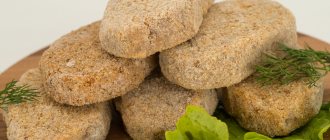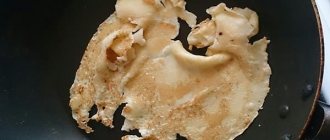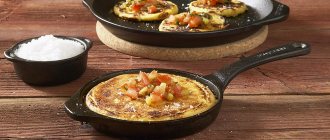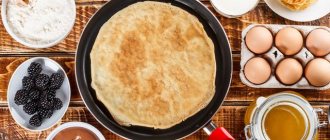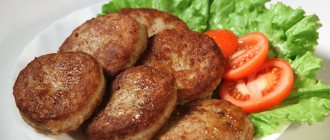If nothing sticks to the pan while frying, then you simply never fry. Vegetables and fish, for example, are guaranteed to stick to almost any frying pan, unless you follow some rules that many people are not even aware of.
In general, there is a certain pattern in what food sticks to the pan and why, as well as several simple ways to help avoid it. However, do not panic if the chicken breast or cutlets still stick to the pan, because the situation can always be corrected, and we will share with you all the main secrets.
Why does food stick?
It is important to understand that during the frying process certain chemical processes occur that cause molecules on the surface of the food and in the hot pan to react. This is a completely natural process and has nothing to do with your culinary skills, so don’t blame yourself for being crooked.
But let's not bore you with a crash course in chemistry, but simply say that high-protein foods, such as meat or fish, stick to the pan more than vegetables. It’s easier to deal with stuck vegetables, but more on that a little later, but for now let’s talk about the relationship between the frying pan and the degree of food sticking to it.
…and what to do with it?
The easiest and most logical way to prevent food from sticking to the pan is to place something between them that can separate them. There's a clever and simple trick I use when I want fried fish with crispy skin that won't have to be pulled off the bottom of the pan. Take a sheet of parchment, fold it in half, then again, then fold the paper in half 2-3 more times so that the fold line each time passes through the corner marking the center of the large sheet. Attach this corner to the center of the frying pan and cut the paper a little earlier than the walls of the frying pan begin, unfold it - and you will get a piece of parchment of a conditionally round shape with a diameter slightly smaller than the bottom of the frying pan, which is called the word “cartouche”. Place it in a frying pan, add oil and fry the fish, pressing it to the bottom with a spatula.
Everything ingenious is simple, isn't it? This technique can be used not only for frying fish, but also in other cases when you are afraid that your food will burn, but frying should not be too long.
But stop! In fact, we always put something between the food and the bottom of the pan that is quite capable of preventing it from sticking. This thing is called "butter".
Which pan does food stick to less?
Of course, the safest option for beginners in the culinary business is a non-stick frying pan. Just don’t think that you need to fry on it without any oil, because that’s not true. It is necessary to add oil, only in the case of a non-stick frying pan you can literally use a drop and not be too careful about the temperature to which it has heated up.
A cast iron frying pan must be heated and lubricated with oil. Yes, yes, precisely lubricate. The oil should penetrate into all pores and cracks, forming an absolutely smooth surface to which food will no longer stick. But the most difficult thing is to fry in a steel frying pan. It heats up quickly but not always evenly, and even if done correctly, food can still stick. To cook in a steel pan, you will need more oil and it is especially important to heat it thoroughly.
Why did food start sticking to the pan?
In the old days, when there were no non-stick coatings, they used aluminum, cast iron, and steel frying pans. Their surface is porous and, when heated, the molecules easily come into contact with microparticles of food. As time passed, the sticking problem partially disappeared because the “pores” became clogged, but some foods still burned.
Modern cookware with various coatings has a smooth surface, eliminating contact between food molecules and metal. But over time, “sticking” will also begin on it due to a change in the quality of the protective layer: it ages, wears out, and becomes thinner. If “sticking” is observed on a new surface, this indicates its low quality and violations in manufacturing technology.
Other reasons:
- use of aggressive chemical cleaning agents and harsh abrasives;
- food residues, fat due to poor washing;
- damage from metal objects (knife, brush, spatula);
- improper use - maximum heating without food, oil, frequent overheating, temperature changes, when cold water is immediately poured after heating.
What to do if food is stuck to the pan
Even if you did everything according to the instructions, food may stick. But don't panic. If at first a piece of meat or chicken breast sticks, then there is a high probability that as soon as these products brown a little, they will come off on their own. You can also rock the pan a little to speed up the process, or move the pieces around while frying with tongs.
Vegetables start to stick much faster than other foods, so the best way to save the situation is to stir them regularly at the very beginning of cooking and use more oil. But in the case of cutlets, it is better to add not oil, but a little water. You won’t get that same treasured crust, but the appearance won’t suffer.
If you often cook omelettes, but they always stick, then try lifting the edges with a spatula first, and then rocking the pan, as is the case with meat. But when frying pancakes, they haven’t come up with anything better than greasing a hot frying pan with oil. The first pancake is lumpy only because the frying pan is not yet hot enough at this point.
Even professionals face the problem of cutlets sticking to the pan. But knowing the intricacies of cooking will reduce the “sticky” risk to a minimum.
